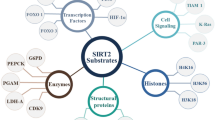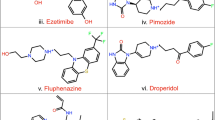Abstract
Numerous studies have demonstrated that the aberrant enzymatic activity of SIRTs has been linked to various diseases like diabetes, cancer, inflammation, cardiovascular diseases, neurodegenerative disorders and therefore, the modulation of SIRTs is of therapeutic importance. The pharmacological action of substituted pyridazinones has been broadly studied and has received much attention on account of especially their cardiovascular, anticancer, anti-inflammatory, and analgesic activity. From this point of view, we evaluated our in-house compounds bearing substituted pyridazinone skeleton for their in vitro inhibitory potency against SIRT2 and the results were supported both by the compatibility with the pharmacophore model previously developed for selective SIRT2 inhibitors and by the interaction fingerprints in hSIRT2 active site. The results revealed that 4-aryl-6-morpholino-3(2H)-pyridazinone functionalized amide scaffold showing 48% inhibition against SIRT2 may be considered as a starting point in the development of new type SIRT2 inhibitors.






Similar content being viewed by others
References
Du J, Jiang H, Lin H. Investigating the ADP-ribosyltransferase activity of Sirtuins with NAD Analogues and 32P-NAD. Biochemistry. 2009;48:2878–90. https://doi.org/10.1021/bi802093g.
Jiang H, Khan S, Wang Y, Charron G, He B, Sebastian C, et al. SIRT6 regulates TNF-α secretion through hydrolysis of long-chain fatty acyl lysine. Nature. 2013;496:110–3. https://doi.org/10.1038/nature12038.
Du J, Zhou Y, Su X, Yu JJ, Khan S, Jiang H, et al. Sirt5 is a NAD-dependent protein lysine demalonylase and desuccinylase. Science 2011;334:806. https://doi.org/10.1126/science.1207861.
Sauve AA, Wolberger C, Schramm VL, Boeke JD. The biochemistry of sirtuins. Annu Rev Biochem 2006;75:435–65. https://doi.org/10.1146/annurev.biochem.74.082803.133500.
North BJ, Marshall BL, Borra MT, Denu JM, Verdin E. The Human Sir2 Ortholog, SIRT2, is an NAD+-dependent tubulin deacetylase. Mol Cell. 2003;11:437–44. https://doi.org/10.1016/S1097-2765(03)00038-8.
Zhang L, Kim S, Ren X. The clinical significance of SIRT2 in malignancies: a tumor suppressor or an oncogene? Front Oncol. 2020;10:1721. https://doi.org/10.3389/fonc.2020.01721.
Zhao Y, Wang L, Yang J, Zhang P, Ma K, Zhou J, et al. Anti-neoplastic activity of the cytosolic FoxO1 results from autophagic cell death. Autophagy. 2010;6:988–90. https://doi.org/10.4161/auto.6.7.13289.
Xu Y, Li F, Lv L, Li T, Zhou X, Deng C-X, et al. Oxidative stress activates SIRT2 to deacetylate and stimulate phosphoglycerate mutase. Cancer Res. 2014;74:3630. https://doi.org/10.1158/0008-5472.CAN-13-3615.
Zhang H, Park S-H, Pantazides BG, Karpiuk O, Warren MD, Hardy CW, et al. SIRT2 directs the replication stress response through CDK9 deacetylation. Proc Natl Acad Sci USA. 2013;110:13546. https://doi.org/10.1073/pnas.1301463110.
Beirowski B, Gustin J, Armour SM, Yamamoto H, Viader A, North BJ, et al. Sir-two-homolog 2 (Sirt2) modulates peripheral myelination through polarity protein Par-3/atypical protein kinase C (aPKC) signaling. Proc Natl Acad Sci USA. 2011;108:E952. https://doi.org/10.1073/pnas.1104969108.
Wang Y-P, Zhou L-S, Zhao Y-Z, Wang S-W, Chen L-L, Liu L-X, et al. Regulation of G6PD acetylation by SIRT2 and KAT9 modulates NADPH homeostasis and cell survival during oxidative stress. EMBO J. 2014;33:1304–20. https://doi.org/10.1002/embj.201387224.
Lagunas-Rangel FA. Current role of mammalian sirtuins in DNA repair. DNA Repair. 2019;80:85–92. https://doi.org/10.1016/j.dnarep.2019.06.009.
Ng F, Tang BL. Sirtuins’ modulation of autophagy. J Cell Physiol. 2013;228:2262–70. https://doi.org/10.1002/jcp.24399.
Seung Min J, Haigis MC. Sirtuins in cancer: a balancing act between genome stability and metabolism. Mol Cells. 2015;38:750–8. https://doi.org/10.14348/molcells.2015.0167.
Carafa V, Rotili D, Forgione M, Cuomo F, Serretiello E, Hailu GS, et al. Sirtuin functions and modulation: from chemistry to the clinic. Clin Epigenetics. 2016;8:61. https://doi.org/10.1186/s13148-016-0224-3.
Zhang Y, Anoopkumar-Dukie S, Arora D, Davey AK. Review of the anti-inflammatory effect of SIRT1 and SIRT2 modulators on neurodegenerative diseases. Eur J Pharmacol. 2020;867:172847. https://doi.org/10.1016/j.ejphar.2019.172847.
Jing H, Hu J, He B, Negrón Abril YL, Stupinski J, Weiser K, et al. A SIRT2-selective inhibitor Promotes c-Myc oncoprotein degradation and exhibits broad anticancer activity. Cancer Cell. 2016;29:297–310. https://doi.org/10.1016/j.ccell.2016.02.007.
Shah AA, Ito A, Nakata A, Yoshida M. Identification of a selective SIRT2 inhibitor and its anti-breast cancer activity. Biol Pharm Bull. 2016;39:1739–42. https://doi.org/10.1248/bpb.b16-00520.
Moniot S, Forgione M, Lucidi A, Hailu GS, Nebbioso A, Carafa V, et al. Development of 1,2,4-oxadiazoles as potent and selective inhibitors of the human deacetylase sirtuin 2: structure–activity relationship, x-ray crystal structure, and anticancer activity. J Med Chem. 2017;60:2344–60. https://doi.org/10.1021/acs.jmedchem.6b01609.
Rumpf T, Schiedel M, Karaman B, Roessler C, North BJ, Lehotzky A, et al. Selective Sirt2 inhibition by ligand-induced rearrangement of the active site. Nat Commun. 2015;6:6263. https://doi.org/10.1038/ncomms7263.
Quinti L, Casale M, Moniot S, Pais Teresa F, Van Kanegan Michael J, Kaltenbach Linda S, et al. SIRT2- and NRF2-targeting thiazole-containing compound with therapeutic activity in huntington’s disease models. Cell Chem Biol. 2016;23:849–61. https://doi.org/10.1016/j.chembiol.2016.05.015.
Outeiro TF, Kontopoulos E, Altmann SM, Kufareva I, Strathearn KE, Amore AM, et al. Sirtuin 2 inhibitors rescue α-Synuclein-mediated toxicity in models of parkinson’s disease. Science. 2007;317:516–9. https://doi.org/10.1126/science.1143780.
Taylor DM, Balabadra U, Xiang Z, Woodman B, Meade S, Amore A, et al. A brain-permeable small molecule reduces neuronal cholesterol by inhibiting activity of sirtuin 2 deacetylase. ACS Chem Biol. 2011;6:540–6. https://doi.org/10.1021/cb100376q.
Ai T, Wilson DJ, More SS, Xie J, Chen L. 5-((3-Amidobenzyl)oxy)nicotinamides as sirtuin 2 inhibitors. J Med Chem. 2016;59:2928–41. https://doi.org/10.1021/acs.jmedchem.5b01376.
Seifert T, Malo M, Kokkola T, Engen K, Fridén-Saxin M, Wallén EAA, et al. Chroman-4-one- and chromone-based sirtuin 2 inhibitors with antiproliferative properties in cancer cells. J Med Chem. 2014;57:9870–88. https://doi.org/10.1021/jm500930h.
Wang L, Li C, Chen W, Song C, Zhang X, Yang F, et al. Discovery of (5-phenylfuran-2-yl)methanamine derivatives as new human sirtuin 2 inhibitors. Molecules. 2019;24:2724. https://doi.org/10.3390/molecules24152724.
Radwan MO, Ciftci HI, Ali TFS, Koga R, Tateishi H, Nakata A, et al. Structure activity study of S-trityl-cysteamine dimethylaminopyridine derivatives as SIRT2 inhibitors: Improvement of SIRT2 binding and inhibition. Bioorg Med Chem Lett. 2020;30:127458. https://doi.org/10.1016/j.bmcl.2020.127458.
Khalil NA, Ahmed EM, Zaher AF, El-Zoghbi MS, Sobh EA. Synthesis of certain benzothieno[3,2-d]pyrimidine derivatives as a selective SIRT2 inhibitors. Eur J Med Chem. 2020;187:111926. https://doi.org/10.1016/j.ejmech.2019.111926.
Eren G, Bruno A, Guntekin-Ergun S, Cetin-Atalay R, Ozgencil F, Ozkan Y, et al. Pharmacophore modeling and virtual screening studies to identify novel selective SIRT2 inhibitors. J Mol Graph Model. 2019;89:60–73. https://doi.org/10.1016/j.jmgm.2019.02.014.
Yagci S, Gozelle M, Kaya SG, Ozkan Y, Aksel AB, Bakar-Ates F, et al. Hit-to-lead optimization on aryloxybenzamide derivative virtual screening hit against SIRT. Bioorg Med Chem. 2021;30:115961. https://doi.org/10.1016/j.bmc.2020.115961.
Akhtar W, Shaquiquzzaman M, Akhter M, Verma G, Khan MF, Alam MM. The therapeutic journey of pyridazinone. Eur J Med Chem. 2016;123:256–81. https://doi.org/10.1016/j.ejmech.2016.07.061.
Süküroglu M, Küpeli E, Banoglu E, Ünlü S, Yesilada E, Sahin MF. Synthesis and analgesic activity of some 4,6-disubstituted-3(2h)-pyridazinone derivatives. Arzneimittelforschung. 2006;56:337–45. https://doi.org/10.1055/s-0031-1296731.
Ochiai K, Takita S, Eiraku T, Kojima A, Iwase K, Kishi T, et al. Phosphodiesterase inhibitors. Part 3: Design, synthesis and structure–activity relationships of dual PDE3/4-inhibitory fused bicyclic heteroaromatic-dihydropyridazinones with anti-inflammatory and bronchodilatory activity. Bioorg Med Chem. 2012;20:1644–58. https://doi.org/10.1016/j.bmc.2012.01.033.
Abouzid K, Bekhit SA. Novel anti-inflammatory agents based on pyridazinone scaffold; design, synthesis and in vivo activity. Bioorg Med Chem. 2008;16:5547–56. https://doi.org/10.1016/j.bmc.2008.04.007.
Sharma D, Bansal R. Synthesis of 2-substituted-4-aryl-6-phenylpyridazin-3(2H)-ones as potential anti-inflammatory and analgesic agents with cardioprotective and ulcerogenic sparing effects. Med Chem Res. 2016;25:1574–89. https://doi.org/10.1007/s00044-016-1588-9.
Asano T, Yamazaki H, Kasahara C, Kubota H, Kontani T, Harayama Y, et al. Identification, Synthesis, and biological evaluation of 6-[(6R)-2-(4-fluorophenyl)-6-(hydroxymethyl)-4,5,6,7-tetrahydropyrazolo[1,5-a]pyrimidin-3-yl]-2-(2-methylphenyl)pyridazin-3(2H)-one (AS1940477), a potent p38 MAP Kinase inhibitor. J Med Chem. 2012;55:7772–85. https://doi.org/10.1021/jm3008008.
Yue Q, Zhao Y, Hai L, Zhang T, Guo L, Wu Y. First synthesis of novel 3,3′-bipyridazine derivatives as new potent antihepatocellular carcinoma agents. Tetrahedron. 2015;71:7670–5. https://doi.org/10.1016/j.tet.2015.07.063.
Zhou S, Liao H, He C, Dou Y, Jiang M, Ren L, et al. Design, synthesis and structure–activity relationships of novel 4-phenoxyquinoline derivatives containing pyridazinone moiety as potential antitumor agents. Eur J Med Chem. 2014;83:581–93. https://doi.org/10.1016/j.ejmech.2014.06.068.
Csókás D, Zupkó I, Károlyi BI, Drahos L, Holczbauer T, Palló A, et al. Synthesis, spectroscopy, X-ray analysis and in vitro antiproliferative effect of ferrocenylmethylene-hydrazinylpyridazin-3(2H)-ones and related ferroceno[d]pyridazin-1(2H)-ones. J Organomet Chem. 2013;743:130–8. https://doi.org/10.1016/j.jorganchem.2013.06.040.
Al-Tel TH. Design and synthesis of novel tetrahydro-2H-pyrano[3,2-c]pyridazin-3(6H)-one derivatives as potential anticancer agents. Eur J Med Chem. 2010;45:5724–31. https://doi.org/10.1016/j.ejmech.2010.09.029.
Zimmerman G, Soreq H. Termination and beyond: acetylcholinesterase as a modulator of synaptic transmission. Cell Tissue Res. 2006;326:655–69. https://doi.org/10.1007/s00441-006-0239-8.
Lin H, Fang H, Wang J, Meng Q, Dai X, Wu S, et al. Discovery of a novel 2,3,11,11a-tetrahydro-1H-pyrazino[1,2-b]isoquinoline-1,4(6H)-dione series promoting neurogenesis of human neural progenitor cells. Bioorg Med Chem Lett. 2015;25:3748–53. https://doi.org/10.1016/j.bmcl.2015.05.084.
Boukharsa Y, Meddah B, Tiendrebeogo RY, Ibrahimi A, Taoufik J, Cherrah Y, et al. Synthesis and antidepressant activity of 5-(benzo[b]furan-2-ylmethyl)-6-methylpyridazin-3(2H)-one derivatives. Med Chem Res. 2016;25:494–500. https://doi.org/10.1007/s00044-015-1490-x.
Schiedel M, Rumpf T, Karaman B, Lehotzky A, Oláh J, Gerhardt S, et al. Aminothiazoles as potent and selective Sirt2 inhibitors: a structure–activity relationship study. J Med Chem. 2016;59:1599–612. https://doi.org/10.1021/acs.jmedchem.5b01517.
Fagbohun OF, Olawoye B, Ademakinwa AN, Oriyomi OV, Fagbohun OS, Fadare OA, et al. UHPLC/GC-TOF-MS metabolomics, MTT assay, and molecular docking studies reveal physostigmine as a new anticancer agent from the ethyl acetate and butanol fractions of Kigelia africana (Lam.) Benth. fruit extracts. Biomed Chromatogr. 2021;35:e4979. https://doi.org/10.1002/bmc.4979.
Fagbohun OF, Oriyomi OV, Adekola MB, Msagati TAM. Biochemical applications of Kigelia africana (Lam.) Benth. fruit extracts in diabetes mellitus. Comp Clin Path. 2020;29:1251–64. https://doi.org/10.1007/s00580-020-03179-9.
Friesner RA, Murphy RB, Repasky MP, Frye LL, Greenwood JR, Halgren TA, et al. Extra precision glide: Docking and scoring incorporating a model of hydrophobic enclosure for protein−ligand complexes. J Med Chem. 2006;49:6177–96. https://doi.org/10.1021/jm051256o.
Acknowledgements
We are grateful to Prof. Mustafa Fethi SAHIN (Eastern Mediterranean University, Faculty of Pharmacy) for his supervisor’s contributions in design and synthesis of the in-house compounds.
Author information
Authors and Affiliations
Corresponding author
Ethics declarations
Conflict of interest
The authors declare no competing interests.
Additional information
Publisher’s note Springer Nature remains neutral with regard to jurisdictional claims in published maps and institutional affiliations.
Rights and permissions
About this article
Cite this article
Sukuroglu, M.K., Gozelle, M., Ozkan, Y. et al. The potential of 4-aryl-6-morpholino-3(2H)-pyridazinone-2-arylpiperazinylacetamide as a new scaffold for SIRT2 inhibition: in silico approach guided by pharmacophore mapping and molecular docking. Med Chem Res 30, 1915–1924 (2021). https://doi.org/10.1007/s00044-021-02782-x
Received:
Accepted:
Published:
Issue Date:
DOI: https://doi.org/10.1007/s00044-021-02782-x




